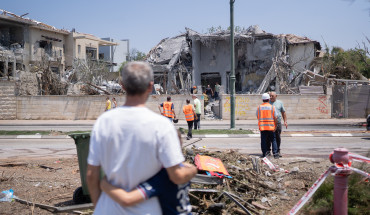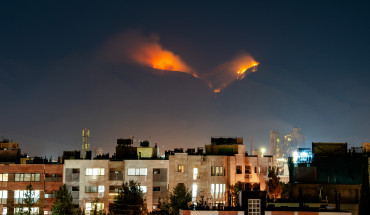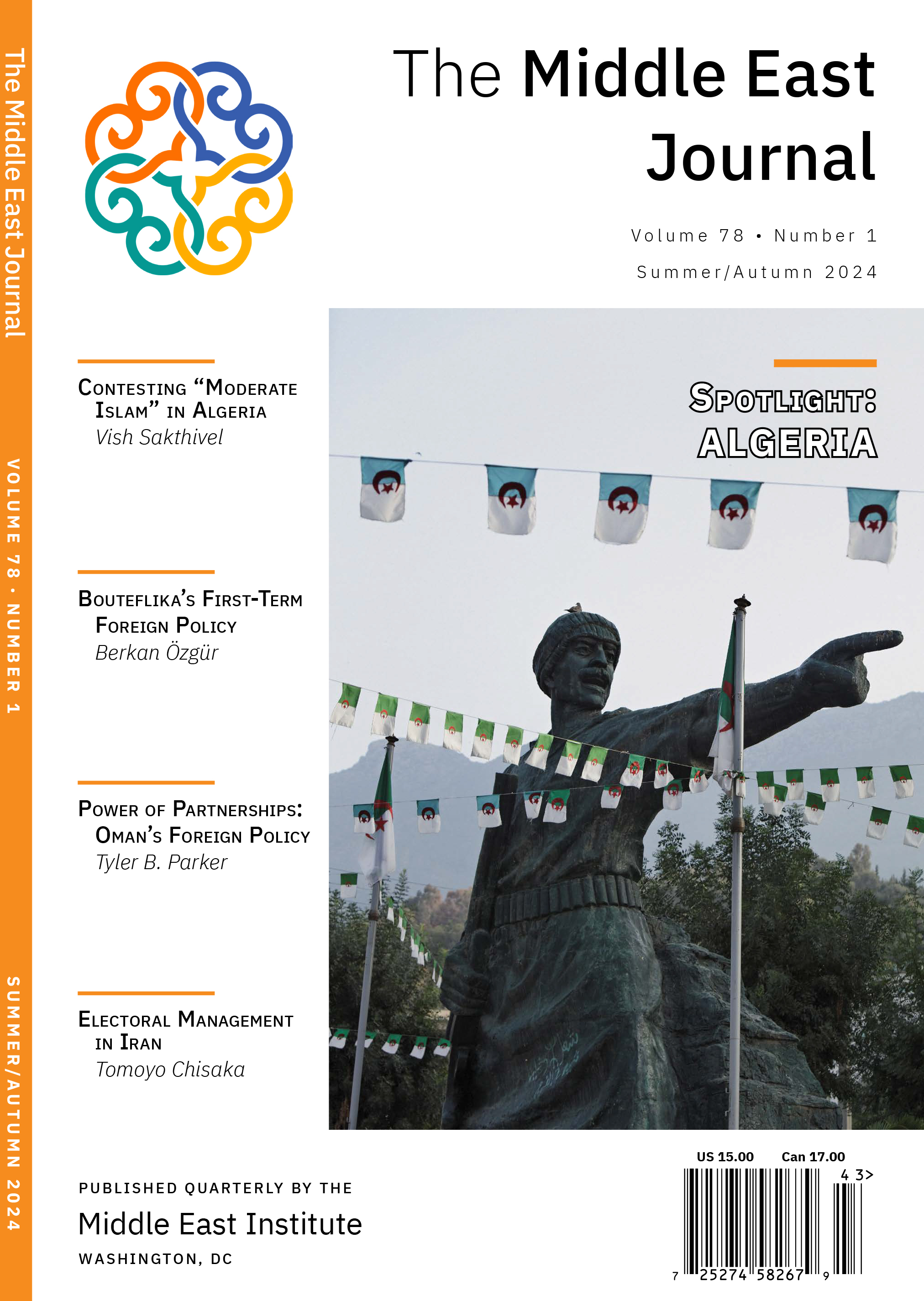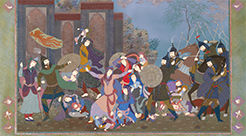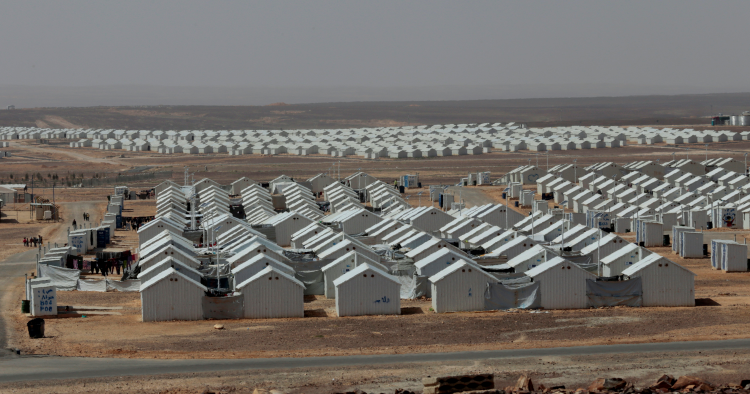This essay is part of a series that explores the human costs and policy challenges associated with the displacement crises in the Mediterranean and Andaman Seas. The essays consider the myths or misconceptions that have pervaded discussions about these two crises, as well as the constraints or capacity deficiencies that have hampered the responses to them. See more ...
Within and beyond the Middle East, scholars, pundits, politicians and ordinary citizens have been preoccupied with what they unanimously describe as the “refugee (migrant) crisis.”[1] The widespread and largely uncritical acceptance that what is happening should be viewed and responded to through the frame of “crisis” has encouraged a sense of temporariness, exceptional measures, and stop-gap policies. Most importantly, it has encouraged a profoundly ahistorical analysis of population displacements and of the international refugee regime that is being called upon to respond to them. In this piece, I therefore ask, what are the intellectual, policy, and human consequences of considering the current displacements a “crisis”?
Making the argument that a “crisis” narrative forces a series of important misconceptions is not intended to suggest that millions of people are not suffering and experiencing horrific human rights violations. Rather, I am arguing that this suffering is largely distinct from the designation of current events as a “crisis.” In describing his life growing up in a refugee camp in Lebanon, the Palestinian writer, Fawaz Turki, stated, “The Palestinian problem has never been to the Palestinian people a crisis, a crisis of political intent, but a tragedy, a tragedy they lived every day of their lives.”[2] War and displacement—for those who are caught up in them—are always a tragedy, one that they carry with and within them far beyond the limited attention spans of international media and scholars. However, not every tragedy becomes a crisis, and it behooves us to interrogate how and with what effects this distinction is drawn.
The Blind Spots of a “Crisis” Narrative
To invoke a “crisis,” according to Janet Roitman, is not simply to describe a given set of circumstances, but necessarily to draw a comparison: a crisis compared to what?[3] The term therefore serves to make a normative assessment about the present, one that implies that there has been a noticeable deviation from an alternative—normal—situation (which either existed or ought to exist). This, in turn, provokes a pattern of reasoning centered on searching for the source of the deviation, in an attempt to answer, “What went wrong?” This normative critique sidelines an investigation of the ways in which a “crisis” may actually occur: not because of a deviation from, but rather because of the routine and intended functioning of a given system. With respect to the current displacements in the Middle East and Mediterranean, the “crisis” label has led to strident recriminations that states’ reluctance to adhere to, defend, and properly implement the international refugee regime has caused unnecessary suffering for millions of people already traumatized by years of war. In so doing, this narrative implicitly assumes that the prioritization of state over human interests is the result of a “broken” refugee regime rather than a consequence of its normal functioning.[4] In fact, however, the international refugee regime—despite its characterization as one of the greatest humanitarian achievements of the post-WWII period—has always prioritized state interests over human interests. Current responses by Middle East (and European) states that undermine human security and violate human rights are therefore not deviations from, but rather predictable outcomes of a state-centered refugee regime that has worked to protect state sovereignty in the face of challenges posed by human displacements.[5] Moreover, in the context of such a regime, humanitarian responses for refugees also tend to protect state interests, irrespective of their declared intentions.
States First, People Second
People have long been displaced—by war, famine, natural disasters—but they have not always been conceived of as “objects of governance,” i.e. as refugees.[6] This shift occurred in response to the massive displacements provoked by the collapse of the imperial-dynastic system and its replacement by a territorially fixed state system in Europe in the early 20th century, which precipitated the first coordinated international efforts to deal with displaced people as such.[7] It was in this period that one of the first High Commissioners for Refugees appointed by the League of Nations, Fridtjof Nansen, was tasked with coordinating the official 1923 population exchange between Turkey and Greece.[8] This exchange saw the legal forced expulsion of nearly two million people—effectively all of the Greek population of Turkey and most of the Muslim population of Greece. The formal involvement of the Commissioner for Refugees in legalized displacement demonstrates the centrality of state interests to how the international refugee regime constituted itself from the very beginning.[9]
This continued post-WWII, when the United Nations Relief and Rehabilitation Administration (U.N.R.R.A.), established by the Allies in 1943 began repatriating displaced people, a policy that grew increasingly controversial following the forced repatriation of millions of Eastern bloc citizens, and the presence of millions more who refused to return. By 1946, these tensions solidified, with the United States holding U.N.R.R.A.’s relief work in the East responsible for legitimating Soviet control and arguing that people were voting with their feet and should not be obligated to return. In response, the Soviet Union denounced U.N.R.R.A.’s reluctance to continue forcibly repatriating citizens as evidence of its subservience to US interests.[10] This led to the establishment of a new temporary organization—the International Refugee Organization I.R.O.)—in 1947. Unlike U.N.R.R.A., the I.R.O. shifted refugee policy from repatriation, which it supported in theory, to resettlement as a policy it implemented in practice. This shift was denounced by Eastern bloc countries as a Western attempt to capture a needed source of labor—a motivation that was indeed behind the resettlement policy.[11] In effect, then, two of the three “durable” solutions of the refugee regime—repatriation and third-country resettlement—materialized in tandem with Cold War politics. Not only did these two solutions emerge from and respond to Cold War interests and alignments, but at the I.R.O.’s inauguration in 1946, the very need to solve the refugee problem in the first place was framed by Eleanor Roosevelt—speaking on behalf of the United States—as “a direct selfish interest” of each U.N. member state. Refugees were not people living tragic circumstances, but rather a “problem” in need of “disposal” and “a sore on the body of mankind.”[12]
With the I.R.O.’s mandate ending, and people still displaced in Europe, negotiations began on the formation of a new refugee agency—the United Nations High Commissioner for Refugees (U.N.H.C.R.), established in 1950. The limitations placed on the organization, particularly its designation as a “humanitarian” rather than “political” agency, served to protect against any possible threat it could pose to national sovereignty. Along with U.N.H.C.R., a Refugee Convention was adopted in 1951. The convention requires states not to expel refugees on their territory and to extend a certain number of rights regarding housing, schooling, documentation, work, etc., to them. However, it does not recognize an unconditional right to asylum.[13] This distinction between a state's duty not to expel and an individual right to asylum effectively preserves states’ right to control entry to their territory; more importantly, much like Roosevelt’s comments, it frames states as actors and refugees as objects of governance.
Although certainly motivated by a humanitarian impulse, this historical sketch serves to highlight the extent to which the establishment of the international refugee regime was fundamentally anchored in and circumscribed by state politics, interests, and priorities. The regime was interested in people as refugees—i.e., as problems for states—rather than in people as human beings tout court. This explains its emphasis on regulating displacements through re-territorialization (in camps, third countries, etc.) and legalization (as “refugees,” “asylum-seekers,” etc.).[14] Promoted as necessary refugee protections, such policies serve to recuperate state sovereignty at the moment when it is radically called into question—i.e., when its territorial integrity is breached by flows of outsiders that it has a moral obligation to assist—by delimiting the destabilizing potential of refugees. In so doing, the regime becomes a tool for state building, with refugees crucial to the “discourse of externality” necessary for the articulation of state sovereignty.[15]
Recuperating State Sovereignty in the Middle East
Refugee-hosting states in the Middle East—such as Lebanon, Turkey, Jordan, and Iraq—are at once lauded for their “hospitality,” censured for their failure to properly protect refugee rights, and excused for not having the adequate resources to effectively do so.[16] While traditional norms of hospitality and cross-border solidarities (of kinship, tribe, religion, etc.) index an indigenous protection framework, these have generally been seen as insufficient to deal with the scale of current displacements. The integration of the region into the international refugee regime—from which it was until recently relatively isolated—has been the advocated response.[17] In a radically shifting context and in the face of strong challenges, the regime—much as it did in the interwar and post-WWII periods—has served principally as a mechanism for regional states to recuperate and strengthen their own sovereignty.
In Lebanon, for instance, the combined pressures of the ongoing presidential vacuum, Hezbollah’s involvement in the Syrian civil war, and the presence of over one million Syrians are regularly cited as moving the country toward the brink of catastrophe.[18] However, the presence of Syrian refugees, and in particular their “violations” of Lebanon’s border, has been crucial for the state. Lebanon’s border with Syria has long held an ambiguous status, with its (non)separation from Syria in practice and principle a source of contention. While the presence of millions of Syrians could be seen as amplifying this ambiguous overlap of the two states, it is in fact producing the opposite effect. It is precisely this presence of a million Syrians as refugees (as opposed to their presence as laborers pre-2011) that allows the Syria-Lebanon border to emerge as a discursive reference around which the idea of Lebanon as fundamentally distinct from Syria can be legitimately consolidated. Crucial in this regard has been the work of international humanitarian organizations, premised as it is on the cataloging of people as Lebanese or Syrian, refugees or not, etc., thereby materializing these statist differences in a way not previously possible.
Turkey is currently host to the greatest number of refugees, almost 2.5 million, most of whom are Syrian.[19] Initially praised for its humanitarian response, Turkey has recently received criticism for signing a deal with the European Union (E.U.) whereby it commits to preventing “illegal” sea crossings and accepting refugees rejected by the E.U., in exchange for monetary support and visa-free access to the European Union. This instrumentalization of refugees has been decried for being against the spirit and letter of the refugee regime, in particular undermining states’ duty not to expel refugees, even when they have entered illegally.[20] However, rather than evidence of its dysfunction, the E.U.-Turkey deal is the outcome of the refugee regime’s emphasis on legal categorization; even though illegal entry should not be grounds for refugee rejections, the promotion of a juridical approach necessarily privileges regularized entry. Moreover, it also requires and legitimates a continued clear separation of refugees from other migrants—established through some form of “evidence,” which implicitly creates the category of the “fake” refugee. In the context of protracted conflicts that produce not just mixed migration flows, but “mixed” migrants (i.e., individuals who move across migration categories), legality therefore acts less as a protection mechanism than a containment strategy. By appealing to the legality inherent in the regime, states greatly limit the number of people who “fit” the refugee category, thereby instrumentalizing refugees through, not against, the regime.[21]
In Jordan, the country’s relatively open border policy applies to Syrians and Iraqis, but since 2013, no longer to Palestinians.[22] Accepting hundreds of thousands of Syrian and Iraqi refugees while refusing a few thousand Palestinians is a discordant policy that has two goals. On the one hand, it strengthens Jordan’s international legitimacy as a regional state through the exercise of its sovereign capacity to protect large refugee populations. On the other hand, it reaffirms its legitimacy as a Jordanian rather than Palestinian state in the face of ongoing Israeli calls for it to be the “alternative” Palestinian homeland.[23] The international refugee regime’s designation of Palestinians as a distinct group not protected by U.N.H.C.R.’s mandate has inadvertently made this distinct set of policies vis-à-vis Palestinians more probable, since it frames them as outside of the regular workings of the refugee regime.[24] Unable to negotiate a different fate for Palestinians, the refugee regime has largely ignored them, with the local coordination task force for humanitarian agencies in Jordan largely silent on Palestinians from Syria.[25] Furthermore, Jordan has a policy of “no parallel systems,” whereby assistance must focus on reinforcing the capacity of Jordanian public infrastructures and services, and programs have to deliver assistance to both refugees and Jordanian host communities. While praised for having the foresight of integrating host community needs into refugee responses, this ostensibly progressive policy has effectively allowed Jordan to place state prerogatives—and not necessarily host community needs—at the heart of the refugee response. Claims that such a “development” approach to refugees is necessary do not acknowledge the extent to which refugee protection can be hindered when tied to broader statist “development” goals.[26]
Beyond “Crisis”
Displacements in the Middle East and other regions are likely to continue, as war, economic dislocations, and worsening environmental conditions increasingly propel movement within and across states. To imagine alternative responses requires the understandably painful and frustrating recognition that despite its human-oriented aspirations, the international refugee regime is bound to fail in guaranteeing the human security of millions. Proponents of the regime nevertheless passionately advocate for its protection and expansion. Their use of a ‘crisis’ narrative promotes a normative position that imagines that a properly implemented refugee regime would prioritize the protection of refugees from the depredations not only of their states of origin, but of host states as well.[27] This narrative, however, does not acknowledge the extent to which the actual system in place—even in its ideal form—is structured to prioritize state interests over human security. Far from being broken, it is working as intended. This is not to suggest that refugees do not receive significant protection from the regime nor that such protections could not be increased; rather, it is to say that this protection will always be secondary to state interests. No additional policies, increased budgets, or new programs will change this fundamental orientation of the refugee regime. In the Middle East, the formalization of the refugee regime has demonstrated this prioritization, as regional states have—as Western states before them—used it as a vehicle for state building rather than primarily as a means of supporting refugees.
Note: This piece draws in part on fieldwork conducted in Jordan (2012-2013), which was generously funded by the International Development Research Centre and supported by the Institut français du Proche-Orient.
___________________
[1] See, for instance: “8 Ways to Solve the World Refugee Crisis,” Amnesty International, 2016, accessed June 28, 2016, https://www.amnesty.org/en/latest/campaigns/2015/10/eight-solutions-wor…; “Migrant Crisis: Migration to Europe Explained in Seven Charts,” BBC News, March 4, 2016, accessed June 28, 2016, http://www.bbc.com/news/world-europe-34131911; Balsari, Satchit et al., “Syrian Refugee Crisis: When Aid Is Not Enough,” The Lancet 385, 9972 (2015): 942–43.
[2] Fawaz Turki, The Disinherited: Journal of a Palestinian Exile, With an Epilogue 1974 (New York: Monthly Review Press, 1972), 144–45.
[3] Janet Roitman, Anti-Crisis (Durham NC: Duke University Press, 2013).
[4] “8 Ways to Solve the World Refugee Crisis.”
[5] Nevzat Soguk, States and Strangers: Refugees and Displacements of Statecraft (Minneapolis: University of Minnesota Press, 1999), 189.
[6] Ibid., 124.
[7] For detailed discussions of conceptualizations of displaced persons prior to WWI, as well as of how the ‘refugee’ emerged in tandem with the territorial nation-state, see: Hannah Arendt, The Origins of Totalitarianism (Orlando, Florida: Harcourt, Inc., 1968).
[8] For more on European population displacements, see: Jessica Reinisch and Elizabeth White, eds., The Disentanglement of Populations Migration, Expulsion and Displacement in Post-War Europe, 1944–9 (Basingstoke, Hampshire, UK: Palgrave Macmillan, 2011).
[9] Soguk, States and Strangers: Refugees and Displacements of Statecraft, 133.
[10] United Nations High Commissioner for Refugees (U.N.H.C.R.), “The Early Years,” in The State of the World’s Refugees 2000: Fifty Years of Humanitarian Action (Geneva: U.N.H.C.R., 2000), 14, 16.
[11] Ibid., 17.
[12] As quoted in, James L. Carlin, The Refugee Connection: A Lifetime of Running a Lifeline (Basingstoke, Hampshire, UK: Macmillan, 1989), 19.
[13] United Nations High Commissioner for Refugees (U.N.H.C.R.), “1951 Convention Relating to the Status of Refugees,” accessed June 18, 2016, http://www.unhcr.org/about-us/background/4ec262df9/1951-convention-rela….
[14] Soguk, States and Strangers: Refugees and Displacements of Statecraft, 194.
[15] Liisa Malkki, “National Geographic: The Rooting of Peoples and the Territorialisation of National Identity among Scholars and Refugees,” Cultural Anthropology 7,1 (1992): 24–44.
[16] “‘I Want a Safe Place’: Refugee Women from Syria Uprooted and Unprotected in Lebanon,” Middle East and North Africa (London: Amnesty International, February 2016), https://www.amnesty.org/en/documents/mde18/3210/2016/en/; “No Safe Refuge: Asylum-Seekers and Refugees Denied Effective Protection in Turkey,” Turkey (London: Amnesty International, June 2016), https://www.amnesty.org/en/documents/eur44/3825/2016/en/; Victoria Mason, “The Im/mobilities of Iraqi Refugees in Jordan: Pan-Arabism, ‘Hospitality’ and the Figure of the ‘Refugee,’” Mobilities 6, 3 (2011): 353–73; David Schenker, “Syria’s Good Neighbors: How Jordan and Lebanon Sheltered Millions of Refugees,” Foreign Affairs, September 28, 2015, accessed June 28, 2016, https://www.foreignaffairs.com/articles/jordan/2015-09-28/syrias-good-n…; Ruben Zaiotti, “Dealing with Non-Palestinian Refugees in the Middle East: Policies and Practices in an Uncertain Environment,” International Journal of Refugee Law 18, 2 (2006): 333–53.
[17] With the exception of Egypt, no Middle Eastern state has adopted the 1951 U.N.H.C.R. Convention on Refugees. Generally, countries have adopted ad hoc regulations governing the presence of Arabs on their territory. N.B. For the purposes of this essay, the Middle East excludes Turkey as per U.N.H.C.R. designation. For more information, see: “The Middle East: Recent Developments” (Geneva: U.N.H.C.R., 2006), accessed July 1, 2016, http://www.unhcr.org/4371d1970.pdf.
[18] Omar Dahi, “The Refugee Crisis in Lebanon and Jordan: The Need for Economic Development Spending,” Forced Migration Review 47 (2014): 11–13.
[19] “Syria’s Refugee Crisis in Numbers,” Amnesty International, February 3, 2016, accessed June 28, 2016, https://www.amnesty.org/en/latest/news/2016/02/syrias-refugee-crisis-in….
[20] The Refugee Convention specifically states that illegal entry is not grounds for rejecting refugees. For information on the Turkey-EU deal, see Patrick Kingsley, “One In, One Out - The EU’s Simplistic Answer to the Refugee Crisis,” The Guardian, March 7, 2016, accessed June 28, 2016, https://www.theguardian.com/world/2016/mar/07/one-in-one-out-the-eus-si….
[21] The criticisms leveled by humanitarian actors against Turkey serve this very same purpose; it is only by appealing to Turkey’s sovereign power that such organizations can then say that it is failing to act properly. Even as they call the state’s actions into question, such criticisms paradoxically re-legitimize state power.
[22] “Jordan: Palestinians Escaping Syria Turned Away,” Human Rights Watch, August 7, 2014, accessed June 28, 2016, https://www.hrw.org/news/2014/08/07/jordan-palestinians-escaping-syria-….
[23] “The ‘Alternative Homeland,’” The Jordan Times, February 24, 2014, accessed June 28, 2016, http://www.jordantimes.com/opinion/hassan-barari/alternative-homeland%E….
[24] Palestinians receive humanitarian services from the United Nations Relief and Works Agency (U.N.R.W.A.). U.N.H.C.R.’s mandate excludes refugee groups that are receiving aid from other specifically designated UN agencies, such as U.N.R.W.A.
[25] “Jordan: Palestinians Escaping Syria Turned Away.”
[26] Nicolas Seeley, “The Politics of Aid to Displaced Iraqis in Jordan,” Middle East Research and Information Project (MERIP) 40, 3 (2010): 37–42.
[27] “Jordan’s Restrictions on Refugees from Syrian Reveal Strain on Host Countries,” Amnesty International, October 31, 2013, accessed June 28, 2016, https://www.amnesty.org/en/latest/news/2013/10/jordan-s-restrictions-re….
The Middle East Institute (MEI) is an independent, non-partisan, non-for-profit, educational organization. It does not engage in advocacy and its scholars’ opinions are their own. MEI welcomes financial donations, but retains sole editorial control over its work and its publications reflect only the authors’ views. For a listing of MEI donors, please click here.






